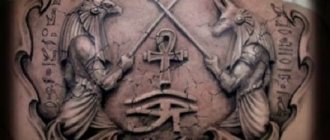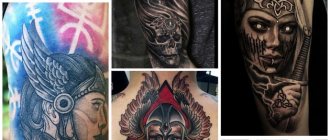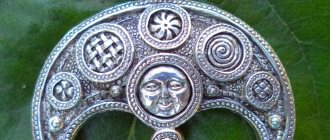Origin of Ouroboros
Archaeologists have discovered that Ouroboros was known to the ancient Chinese, Indians, Scandinavians, Egyptians, and Greeks . On amulets he was depicted in a looped form, biting his own tail. An alternative traditional version of the image is in the form of a lying number 8. The name we know is formed by two ancient Greek words: tail, food.
Ouroboros on an ancient bas-relief
Scientists do not know exactly when and where the dragon biting its own tail first appeared. Undoubtedly, this happened in ancient times, but very little reliable information from those times has reached our days. This makes it difficult to determine the exact meaning of the symbol.
Ouroboros is comparable in prevalence to the Tree of Life .
It is found in almost all ancient cultures. Many centuries have been accompanied by a transformation of sacred meaning. Externally, the sign has undergone relatively minor changes.
Ouroboros. What kind of animal?
Ouroboros is one of the options for depicting a snake in which it holds its tail with its teeth. It is believed that this symbol is one of the oldest. Moreover, the exact time of its occurrence is not clear. However, there is an opinion that this symbol came to the culture of Western countries from Ancient Egypt. He was a symbol of rebirth and the unity of life and death. There are still doubts about where exactly the image of the ouroboros originated, since similar symbols appeared in both Scandinavia and China.
Ouroboros tattoo on a girl's chest
Ouroboros was also actively used by philosophical schools of different times. For example, in Gnosticism it was given a separate place. In Gnostic teachings, ouroboros is a symbol of light and darkness. The inhabitants of Ancient China adhered to a similar concept. They identified this symbol with the designation of Yin and Yang. The ouroboros tattoo, a photo of which can also be found in conjunction with a white egg, can also mean the unity of the masculine and feminine principles.
Similar symbols among different ancient peoples
Archaeologists have found that Ouroboros, the meaning of which is ambiguous in the modern interpretation, was used by people who lived in Mesopotamia. Ancient Babylonian artifacts do not reveal the meaning of the sacred sign, they only contain its description.
The symbol is found in artifacts from different parts of the world
Egypt
Some researchers believe that the sign of the Ouroboros serpent was first used by the ancient Egyptians . In their mythology, an impressive part is dedicated to the world of the dead. There was a cult of the afterlife. Modern tourists know about Anubis and the pyramids, mummies preserved for thousands of years, but few know about the connection between the Egyptians and the colo Ouroboros. In those days, it was believed that the snake existed on the edge of our world and the other world. In the minds of the Egyptians, a snake, capable of devouring its own tail, guarded another world, accompanied the dead and controlled the process of the appearance and departure of people. Ouroboros is associated with the Ankh, another very famous ancient Egyptian symbol.
The ancient Egyptians believed that the snake united all the elements and planes of existence. Archaeologists believe that the importance of the symbol is proven by images of the dragon in chronicles on the walls and in ancient literature.
Greece
In ancient Greek mythology, a coiled snake biting its own tail symbolized infinity . For them, being contained the beginning and end of the Universe. The symbol showed a closed spiral progress - a transition from stage to stage with development along one line.
For the ancient Greeks, the design of a coiled snake had in common with the Phoenix, a magical bird that was reborn after dying. Like the mystical dragon, the bird is present in various cultures, symbolizing immortality and renewal.
China
In the history of Ancient China, snakes are one of the key mythological creatures . Subsequently, it was from the coiled snake that the image of the mustachioed dragon emerged, which is still popular today. The eastern dragon has retained many of the visual features of its predecessor - it is like a snake and has small legs.
By changing the appearance of the symbol, the ancient Chinese somewhat revised its meaning. The loop of the original sign symbolized good luck, and the mustachioed dragon was seen as a patron. From its earlier meaning, the new image adopted the idea of harmony of opposites. It depicts the coexistence of death and life, light and darkness. This concept is the basis of the idea of Yin-Yang .
Ouroboros - the progenitor of the mustachioed dragon
Scandinavian legends
In the north, a snake biting its own tail was not viewed as positively as in the rest of the ancient world. In myths he was called the giant creature Jörmungand . The ancient Scandinavians believed that he lived under water and embraced the entire earth with his body. By biting its own tail, the snake closes the magic ring. This mythological character was negative for the northern peoples .
In legends, Jörmungand is not always large: it grows over time. Myths say that the end of the world will happen when the snake bites its tail. He will not be the only one to suffer - chaos will engulf humanity and the gods. Ancient people also saw something good in this: the end of one world meant the beginning of a new one, with different deities and a different fate.
Ouroboros is as common as the Tree of Life
Popular Subjects and Places for Snake Tattoos
Snake Tattoo Around Arm
A snake that curls around the shoulder or forearm looks very graceful. Such a tattoo can emphasize both the beauty and elegance of a woman’s hand and the strength of a man’s hand. The snake symbol has no gender; it can be close in meaning to both men and girls.
Snake Tattoo on Thigh
A large drawing is usually placed on the thigh, which allows the master to draw the entire sketch in detail. Depending on the idea, the tattoo can be placed on the front or side of the thigh. You can depict a snake wrapped around your leg or get a tattoo on the back of your thigh.
Snake Tattoo on Leg
Small sketches for girls look very beautiful on the feet. Also, the snake depicted around the ankle makes the line of the leg visually more expressive.
Snake Tattoo on Hand
There are many options for how to place a sketch of a snake on your hand. This could be a small design on the wrist or a large sleeve tattoo. Think about what is most important to you in a tattoo: if you want to convey symbolism, then a small tattoo will be enough. And if you like the unusual texture of snake skin, then you should think about a large, realistic tattoo.
Snake and Dagger Tattoo
Snake and Dagger tattoos have a warlike character. Such a drawing can be interpreted as a willingness to fight shortcomings, weaknesses, and temptations. And the second meaning is the desire to fight, to destroy something old in the name of the new.
Snake and Rose Tattoo
Such a tattoo can have a variety of meanings, so you shouldn’t look for other people’s interpretations if you can create your own. For example, you can find different meanings of rose depending on the color. Add a snake to the composition as a symbol of wisdom and contemplation. For example, a tattoo of a snake and a rose can mean fidelity to one’s feelings, resistance to temptation and betrayal, and eternal love.
Snake Tattoo Realism
Realistic snake images feature very beautiful, textured snake skin detail. Unique patterns of coiled snakes are most often made in color.
A snake biting its own tail in the religions of Indo-China
For Christians, Jews, and Muslims, the snake is a negative symbol that deceives Eve and forces her to commit an offense that leads to expulsion from paradise. Eastern religions perceive the symbol more positively. Hindus call the snake that bites its own tail Shesha . People believed that the mythological entity had thousands of heads, and that she herself was the divine support on which Vishnu , the Guardian of the Universe, sits. The coiled snake body forms the pedestal of the throne, and numerous heads, frightening with their open hoods, protect the deity from ill-wishers.
Ouroboros is known to Buddhists. Some researchers are convinced that the main symbol of Zen is a calligraphically depicted snake, drawn with one stroke of the brush without lifting it from the paper. Its end and beginning touch, like Ouroboros.
The Ouroboros is supposedly depicted in the Zen symbol
In China and Indochina they believed in naga - snake-like mythical creatures. Their mother is named in the legends as Kadru , one of the wives of Kashyapa. Huge nagas lived in the underground plane of Patala, in luxurious palaces decorated with gems and gold. The wise Vasuki reigned in this state. His throne stood in the city of Bhogavati, which thundered throughout the underworld with its incredible treasures. Other nagas chose the ocean, river bottom, and underground reservoirs as their habitat. They can live on the earth's surface, protecting treasures. Royal snake-like mythical creatures own countless riches. The leaders of this tribe are wise, strong, and friendly with the gods. The word “naga” itself can be translated as “ wise serpent ”.
Psychological aspects
Ouroboros is an archetypal ancient sign, symbolizing the cyclicality and infinity of the Universe. It is associated with endless processes that do not have a clear beginning: changing time of day, seasons, phases of the moon. In the minds of ancient thinkers, life and death, replacing each other, are cyclical. The prevalence of the symbol is comparable to the popularity of the swastika.
Because of its prevalence, Ouroboros is of interest to psychologists.
The theory of psychology could not miss such an interesting object of study. Carl Jung, the creator of the theory of archetypes, began researching the prevalence of the serpent. He interpreted the snake biting itself as a visualization of human dualism: in each person destructive tendencies fight with creative impulses . The state of Ouroboros is unattainable consciously; it symbolizes impeccable harmony, balance, characteristic only of an infant. The desire for such a state is the key to mental balance.
The meaning of Ouroboros in alchemy
Alchemists saw Ouroboros as a symbol of the transformation of substances into the philosopher's stone, which they strived for. The serpent combined ideas of harmony and chaos at the same time, an endless alternation of destruction and the emergence of the new. The creature biting its own tail completed the dual pair.
In the Middle Ages, alchemists used the Ouroboros symbol to represent formulas. In the 18th century, most stages of the action were marked with such an image . Often they depicted a snake and an egg, an ingredient in an alchemical reaction. Ouroboros symbolizes the completion of the transitional stage, the transformation of the elements and the development of being. Alchemists often depicted the snake as having two heads. It was simultaneously empty, full, circle - that is, all the components of universal power. The head symbolized passivity, emptiness and attractiveness. Tail – fullness, activity, rejection. Ouroboros is a symbol of an attempt to absorb the ever-evading tail with the head. Between the end points is the space to which the laws governing motion apply.
The cyclical nature of the Universe
In some alchemical works, Ouroboros is depicted around a child, symbolizing the beginning and completion of creation and life.
Meaning of Snake Tattoo
Tattoo of a snake that bites its own tail ( Ouroboros Tattoo
) - a symbol of
infinity, cyclicity, eternal movement of life
.
This symbol is so ancient that even scientists can only speculate about its true meaning. In the old days, people interacted very closely with nature, so the Ouroboros symbol most likely means constant cyclicality in nature
.
Also, the Snake Tattoo has the meaning of wisdom, knowledge
.
Snake with cross tattoo
means the victory of the spirit over the flesh, victory over temptation.
In Ancient Egypt, the snake symbolized the Sun, energy
.
In India, and in some other regions, snakes are often the guardians of shrines, sources of water and treasures. This tradition is associated with the symbolism of fertility inherent in the snake, and with the belief that precious stones are the congealed saliva of snakes.
In Eastern traditions, a snake tattoo will have a similar interpretation as a dragon tattoo.
In the Christian tradition, the snake is associated with sin and temptation. Although a tattoo with a snake can mean a person’s victory over temptation, exaltation, or past trials.
Snake tattoo can mean mistrust
. A person who has often been subjected to deception and betrayal may stuff himself with a snake as a sign that he does not trust people.
Ouroboros as an amulet, talisman
Such amulets were used both previously and now. A snake biting its tail is considered a strong sign, reflecting the cyclical nature of time and reward for completed deeds. He calls for justice. By wearing a pendant with this sign, they receive the karmic right to give what they deserve. The evil caused to the owner of the symbol will certainly return to the source in full . The product helps only a person with inner strength. If a weak person uses it, Ouroboros devours the soul, will, and strength.
Ouroboros - a powerful amulet
In the Middle Ages, the dragon was a hallmark of people who rejected conventional religious dogma.
To feel the power of the amulet, it is necessary before use . For this:
- Bury the object in table salt.
- Leave it for a day.
- Rinse with running water.
- Throw away (bury) the used salt.
There is no need to charge the amulet; it is enough to ask words for help in development and achieving harmony. The amulet is suitable for persons of any gender who have a strong will and the ability to keep themselves in balance. Ouroboros will harm a weak person, develop complexes, and lower self-esteem. There is no negative, positive pure energy in the symbol showing the cyclical nature of the Universe. Such a talisman is suitable for those who believe in natural forces, and not religious dogmas. Christians, Jews, and Muslims are not allowed to use a snake that bites itself .
Ouroboros in amulets is not suitable for Christians
Magic properties
Ouroboros protects the owner from black magic spells, enemy slander, and dark witchcraft. The snake is an amulet that symbolizes reward for accomplished deeds. Evil towards the owner of the colo will certainly return to the ill-wisher, and everything done will be to his detriment. Properties of the amulet :
- the ability to guide in helping others;
- protection from evil, black magic;
- an indication of fair actions and decisions.
Ouroboros - a magical symbol
Historical artifact as a talisman
The Ouroboros symbol was depicted on tombstones in order to connect life and death. Medallions in the shape of a snake eating its tail are found on the bodies of buried people.
Among the Slavs, the snake symbolized infinity. This creature, nicknamed the lizard, guarded the treasures. Therefore, Ouroboros acquired protective properties. Talismans with such an emblem began to be made to protect oneself and family from troubles, illnesses and even black magic.
Necklace
The jewelry is made of silver, gold, precious and semi-precious stones. There are pendants made of unusual materials, such as elk antlers, sperm whale teeth or mammoth ivory.
The neck pendant is made of silver.
Wrist bracelet
The hand of the owner of such jewelry is wrapped in the body of a snake or dragon, the locks are made in the shape of its head and tail. Popular materials for the body are leather and coral stones. The bracelet can also be made in an unusual version - from the vertebrae of a snake.
Sacred amulet
The amulet can look like a simple decoration on the neck or arm. The main thing is the meaning that the owner puts into it. It is believed that such a talisman helps to find inner harmony and self-control. It eliminates fears and develops the best qualities in a person.
A sacred amulet can look like a simple decoration.
Finger ring
The Ouroboros plot in the ring is suitable for both men and women. For the latter, there is a symbolism of wearing jewelry on different fingers:
- large - attracting love and fertility;
- index and nameless - for career success.
Symbol tattoo
A tattoo with such a sign is made by someone who wants to return the harm caused to him to the source. The symbol is chosen by men and women of different ages. There are no restrictions on the choice of colors. The image is suitable for a person striving for personal growth and development. Ouroboros is the choice of someone who believes in the cyclical nature of what happens and strives to eradicate a person’s personal shortcomings.
Tattooists believe that any part of the body is suitable for depicting a snake biting its own tail. Most often chosen:
- back;
- stomach;
- shoulder.
Some people believe that a tattoo enhances sexuality or gives power. Wrong interpretation leads to the awakening of negative energy. It is wise to get a tattoo after knowing the secret meaning of the symbol.
Tattoo on the back with a symbol
Ouroboros in the modern world
For esotericists of our time, Ouroboros is a symbol of the cyclical nature of the Universe, the unity of life and death, the balance of good and evil. Such opposing aspects have always existed – and will continue to do so in the future. A person is unable to see good without knowing evil, unable to know light if there is no darkness.
Modern psychologists see Ouroboros as a symbol of the duality of human nature . The sign is associated with childish behavior - sometimes obedient, often unpredictable, not always kind. Research on the snake continues.
Ouroboros is now popular as a talisman. They protect themselves from the evil eye and dark forces.
The mark is common in the jewelry industry. Jewelry with Ouroboros is highly prized.
There are many decorations with the symbol
Meaning in Western countries
In German-Scandinavian mythology, snakes, in principle, rarely denoted any positive aspect. The very motive of snake fighting as the hero’s path is very European and Scandinavian motifs. In these mythologies, the Ouroboros is a serpent who has clasped the earth with its body and is waiting for the end of the world or Ragnarok to emerge from the waters and poison the sky. He is not unconditionally evil, he simply performs his ancient function. There's an interesting oxymoron here. The serpent, which signifies eternity, is also the one who will put an end to the world. This also gives the ouroboros a philosophical meaning; a tattoo with it can remind one of the finitude of life, the inevitability of leaving for another world.









